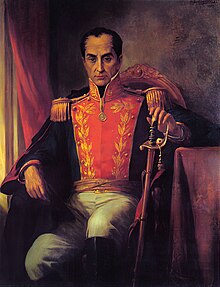Palacio de San Carlos, Bogotá

The Palacio de San Carlos, also Cancillería de San Carlos, is an elegant 16th-century Neoclassical mansion in Bogotá, Colombia. It is a historic building which has witnessed many political, social and academic events. Since December 1993, it has been home to the Ministry of Foreign Affairs.[1][2]
History
The history of the building goes back to the end of the 16th century when it was built by Archdeacon Francisco Porras Mejia, in 1585. At the time Santa Fe de Bogotá was the capital of New Granada, part of the Viceroyalty of Peru. It was occupied by the archdeacon's family until 1605 when it was sold to Archbishop Bartolomé Lobo Guerrero who used it as a Jesuit seminary known as the Colegio Seminario de San Bartolomé.[2][3] In 1739, the first printing press of Sante Fe was also established here.[2] In 1767, after the Jesuits were expelled by Francisco Antonio Moreno y Escandón, an official acting on orders from King Carlos III, it became the Royal Library of Santa Fe and served as a barracks for the Presidential Guard. From 1827 to 1908 the palace was the official residence of the President of Colombia. Then President Rafael Reyes moved out to the Palacio de Nariño where he lived till 1954. From 1954 it again became the residence of General Gustavo Rojas Pinilla and his successors till 1980. In 1980 after the Palacio de Nariño was inaugurated as the presidential residence, the Palacio de San Carlos was converted to house the Ministry of Foreign Affairs which it still accommodates today.[2][3]

The palace was also the scene of an assassination attempt on Simon Bolivar in 1828. He was attacked when a group of conspirators attempted to assassinate him while he was taking a bath and he escaped through the window with soap still covering his body. His friend Manuela Saenz who tipped him off and saved him came to be known among Bogotans as "the liberator of the liberator". The event came to be known as the "September Conspiracy" or the "Nefarious September Night". A conspicuously fixed plaque, stating this fact in Latin, is displayed on the wall next to the window.[1][4][5][6] In 1937, properties next to the palace were acquired on the eastern side. The main entrance was added along with a triple storied building to accommodate the offices of the Ministry. Built by the Italian architect Pietro Cantini, the new facade stands close to two other historic buildings on Calle del Coliseo (Calle 10): the birthplace of the poet Rafael Pombo and the Teatro de Cristóbal Colón. On 11 August 1975, the Palace of San Carlos was declared a National Monument.[2][7]
On 9 April 1948, the palace was attacked during the popular uprising which caused damage to its interior decorations.[1]
Interior and furnishings

The building has been completely restored to serve as a heritage site and as a venue for diplomatic receptions and special events. It is known for its elegant state rooms. In its patios, there is a walnut planted by Bolívar and a palm which President José Hilario López planted to commemorate the birth of his daughter Polita.[2]
The large entrance hall displays six 18th-century Spanish chairs in the Cordoba style and a central table. Two large 19th-century bronze vases flank the stairway at the far end. Bolivar's bedroom is furnished with a 17th century bed and a bargueño desk with secret drawers. The neighbouring Oratory with works from the Santa Fe school and an altar in the colonial style with two florally decorated candelabras. Since colonial times, the Bolívar Room opposite the bedroom has been a venue for important official ceremonies. It houses a portrait of Bolívar by the Venezuelan artist Antonio Salguero and a fireplace with two Solomonic columns.[2]
The ceiling in the entrance to the state rooms is decorated with a Pompeian fresco by Santiago Martínez Delgado (1950). The large Audience Hall features a carpet with a hunting scene and carved wooden chairs with a gold-leaf finish. The Cabinet Room accommodates a flag of the United States of Columbia from 1863.[2]
Most elegant of all is the Francisco de Paula Santander Room which is traditionally used as a reception hall for celebrities visiting the country. Its gold-toned walls bear damasks from Italy. A giant rococo mirror complements the two colonial tables. There is a painting of the Virgin and Child from the Cuzco School and a portrait of the Castillian president, José Joaquin. The 18th-century furniture is from Spain.[2]
References
- ^ a b c "Palacio de San Carlos" (in Spanish). Official web site Toursim deparment of Bogoto. Retrieved 19 May 2013.
- ^ a b c d e f g h i "Historia Palacio San Carlos", Ministerio de Relaciones Exteriores. Template:Es icon Retrieved 17 May 2013.
- ^ a b Benjamin Villegas (1 January 2003). Bogota: From the Air. Villegas Asociados. pp. 195–. ISBN 978-958-8156-22-4. Retrieved 18 May 2013.
- ^ Michael Kohn; Robert P. Landon; Thomas B. Kohnstamm (2006). Colombia. Ediz. Inglese. Lonely Planet. pp. 62–. ISBN 978-1-74104-284-9. Retrieved 18 May 2013.
- ^ Jens Porup (15 September 2010). Colombia. Lonely Planet. pp. 73–. ISBN 978-1-74220-326-3. Retrieved 18 May 2013.
- ^ "Lonely Planet review for Palacio de San Carlos". Lonely Planet. Retrieved 19 May 2013.
- ^ "Historia del Palacio de San Carlos", Cancillería: Ministerio de Ralaciones Exteriores. Template:Es icon Retrieved 19 May 2013.
4°35′47″N 74°4′29″W / 4.59639°N 74.07472°W
